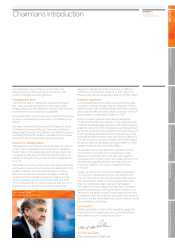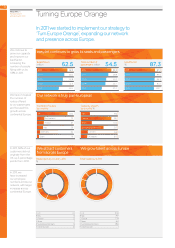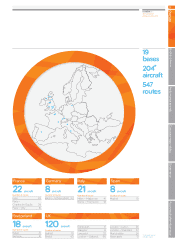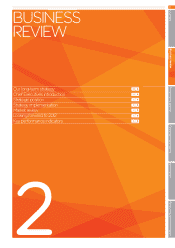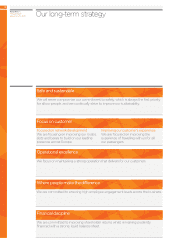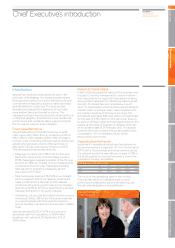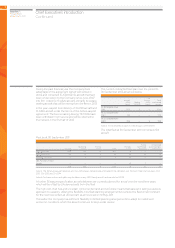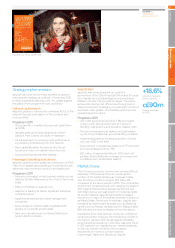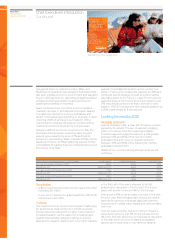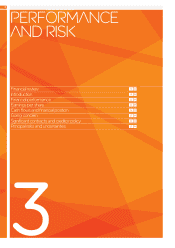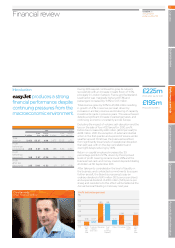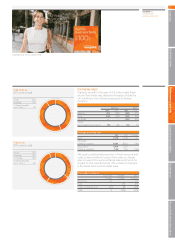EasyJet 2011 Annual Report Download - page 15
Download and view the complete annual report
Please find page 15 of the 2011 EasyJet annual report below. You can navigate through the pages in the report by either clicking on the pages listed below, or by using the keyword search tool below to find specific information within the annual report.
easyJet plc
Annual report
and accounts 2011
13
Overview Performance and risk Corporate responsibility Governance Accounts & other information
Business review
Strategy implementation
easyJet has continued to make excellent progress in
executing the strategy as outlined in November 2010
to drive sustainable planning cycle. An update against
the pillars of the programme is set outbelow.
Network optimisation
easyJet’s goal is to improve the underlying ROCE of the
network through optimisation of the schedule and
route portfolio.
Progress in 2011
– Strong growth in mainland Europe with seats flown
up18.6%
– Valuable peak times slots obtained at London
Gatwick, Paris Charles de Gaulle, Amsterdam
– Clinical approach to reviewing route performance
e.g.dropping Gothenburg from the network
– New capital allocation framework introduced
focusing on return on capital metrics by route
– Supporting business traveller strategy
Passengers travelling on business
easyJet’s goal is to drive additional contribution of £100
million from passengers travelling on business through
delivering improvements in product and distribution
Progress in 2011
– Frequency increased on key business routes such as
Gatwick to Milan Malpensa up from four to five times
a day
– Rollout of flexifare on easyJet.com
– Sales force starting to deliver, significant enterprise
contracts signed
– Agreements reached with travel management
companies
– Key business to business deals negotiated with
pipeline of corporate growth deals
– New commercial freedom in Global Distribution
System (GDS) contracts
easyJet lean
easyJet’s lean projects are set up under the
sponsorship of the Chief Financial Officer and the goal
is to maintain its cost advantage by ensuring below
inflation non-fuel cost per seat increases. This will be
achieved by driving cost efficiencies through best in
class procurement, leveraging our scale, tight control of
overhead costs, greater crew flexibility and improved
operational performance.
Progress in 2011
– Unit costs (excluding fuel) fell by 1.3% at constant
currency with strong performances in ground
handling, maintenance and disruption related costs
– Process re-engineering to deliver cost optimisation
e.g. de-icing in Malpensa; ground handling contracts
– Implemented plans to increase proportion of lower
unit cost A320 in the fleet
– Improvement in operational resilience. OTP improved
by 13 percentage points to 79%
– £92 million of savings identified in 2012 which will
partially offset inflationary increases and investment
in initiatives such as allocated seating
Market review
The UK macroeconomic environment remains difficult,
especially in the travel and tourism sector as the
number of UK residents taking an overseas holiday
over the three months to August 2011 fell by 4%
compared to the same period in 2010. The competitive
environment remained tough with capacity increases in
2011. Against this backdrop easyJet performed well
with total revenue per seat growth of mid single digits.
At London Gatwick easyJet significantly increased
frequency on many of the busiest business routes such
as Madrid, Milan, Rome and Amsterdam. easyJet also
increased its market share at bases such as Bristol as
carriers such as Ryanair retreated, and in Glasgow after
BMI withdrew services to Heathrow from the airport.
Despite the Euro-crisis German consumer confidence
remained positive. However, the introduction of APD in
Germany in January 2011 has damaged profitability
across all airlines operating in Germany. easyJet’s focus
in 2011 has been on maintaining our market leadership
on key city routes from Berlin with increased
frequencies on routes to London Gatwick,
Copenhagen, Basel and Barcelona. easyJet
+18.6%
Growth in mainland
Europe capacity
c£90m
Savings identified
for2012
Example only. Not a current offer.


